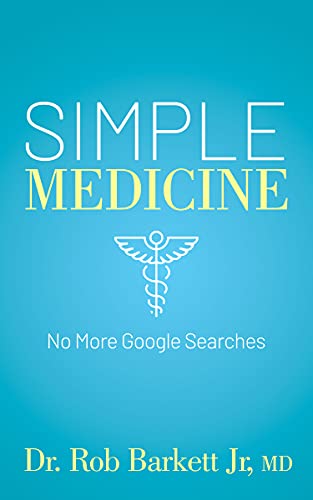Dr. Rob Barkett Jr, MD
Simple Medicine chronicles the changes in primary care medicine over the past 50 years. Despite all the new medical technology, studies, medications, specialization, and computers, medical care is fractured. The physician-to-physician relationships have decayed.
This book lets you review your medical conditions in a concise manner and know where to go next.
Available at:
Have you ever googled your medical condition, started having a panic attack and gone absolutely crazy about the possible diagnosis? This book will help you from jumping off the cliff and soothe your mindset!
About The Book
The federal government and insurance companies are dictating what they think is appropriate medical care. Too many patients are over medicated and not receiving the standard of care that is warranted in 2021. In Simple Medicine, the most common medical conditions, complaints, screening, medications, and medical testing are described in layman terms and very easy to understand, helping patients take control of their own health care and challenge their doctor to do the right thing.
Introduction
Growing up as a doctor’s son in a smaller community, I was quite starry-eyed about medicine. The doctors I observed were curing the masses, loved, respected, placed upon a pedestal, wealthy, and intelligent. During medical training and after passing medical board examinations, I could diagnose and treat problems A-to-Z. The problem lies in that primary care providers may see the majority of conditions once or twice in a lifetime. I have provided the most common conditions that physicians will treat on a daily basis, and they must be familiar with the atypical presentations of the common conditions. For older physicians that are stuck in their old ways, it is hoped they will see that life-changing medications and treatments are at their disposal.
Today I am a grizzled veteran of twenty-seven years in primary care medicine. I have two target audiences: the general public who are invested in their health, and other primary care physicians. In the pages that follow I will bridge old and new school medicine and preserve the past traditions while embracing new technologies. I address the changing doctor-patient and doctor-doctor relationships that are quite different in this day and age.
I began practicing medicine in an autonomous situation where I could prescribe any medicine or order any study I desired. Medicine is no longer autonomous as insurance companies dictate what the physicians may do. Patients are information hungry and desire instant gratification. Patients no longer discuss their symptoms with me; they just tell me their diagnosis. Google search has taken over their medical care. When I Google certain diseases, differential diagnoses, and medications, it is often difficult for even me to understand them; it is very time-consuming, and nothing is concise. I have written this book in layman’s terms and hope the general public will understand it clearly.
During patients’ office visits, doctors speak in medical terms and discuss diagnostic testing and disease states as if patients actually understand what they are telling them. What I’ve done here is provide patients a CliffsNotes version of common disease, laboratory review, simplified testing, and medications that should be prescribed for common problems. Patients deserve to know what doctors are thinking and why we are prescribing certain medications and not prescribing others that are potentially harmful for them. Multiple, different, equally effective cancer screenings, tests, and treatment plans exist for every disease. My recommendations reflect the standard of care and are cross-referenced with the American College of Physicians publication, Medical Knowledge Self-Assessment, Number 17.
I have grown bitter with the change in medicine throughout the years. Big business and technology have ruined the physician-to-physician relationships. Communication between physicians is awful as information is passed on by a fax or redundant chart notes from the electronic medical record (EMR). A phone call is almost extinct between the specialist and primary care physician. Also, EMR has changed the whole dynamic of routine office visits with patients. No longer can doctors practice medicine like the empathetic and caring Marcus Welby, MD! Since I was trained in old-school medicine and have adapted to the new technology, hospital-owned practices, hospitalists, and EMR, I believe my advice will be beneficial to medical students, residents, and young doctors, and I hope it will rattle the chain of large hospital institutions.
Sincerely,
Robert E. Barkett Jr., MD
What’s inside
Section 1: The Changing Medical World
The Decay of Physician-to-Physician Relationships
- Know Your Patients
- Staff
- Nurses
- Billing Department
- Electronic Medical Records
- The Examination
- Honesty
- Follow-Up Care and Consultations
- Reality with Patients
- Internet
- Urgent Care
- Physician Burnout
Section 2: Medical Conditions
Chapter: Hypertension
Chapter: Type 2 Diabetes Mellitus
Chapter: Atrial Fibrillation
Chapter: Congestive Heart Failure
Chapter: Chest Pain
- Angina
- Gastroesophageal Reflux Disease
Chapter: Hepatitis
- Autoimmune Hepatitis
- Hepatitis A, B, or C
- Hereditary Hemochromatosis
- Non-Alcoholic Fatty Liver Disease
- Primary Biliary Cirrhosis
Chapter: Cancer Screening
- Breast Cancer Screening
- Cervical Cancer Screening
- Colon Cancer Screening
- Lung Cancer Screening
- Prostate Cancer Screening
Chapter: Dementia
- Alzheimer’s Disease
- Frontotemporal Dementia
- Lewy Body Dementia
Chapter: Depression
- SSRI
- SNRI
- NDRI
- Trintellix
Chapter: Hyperlipidemia
- Cholesterol
- Hypertriglyceridemia
Chapter: Vaccines
- Influenza Vaccine
- Pneumococcal Vaccine
- Shingles Vaccine
Chapter: Cigarette Cessation
- E-Cigarettes
Chapter: Marijuana
Chapter: Alcoholism
Chapter: Obesity
Chapter: Sleep Apnea
Chapter: Asthma
Chapter: Chronic Obstructive Pulmonary Disease
Chapter: Headache
- Migraine Headaches
- Temporal Arteritis
Chapter: Dizziness
- Acute Vestibular Syndrome
- Meniere’s Disease
- Near Syncope
- Vertigo
Chapter: Erectile Dysfunction
Chapter: Abdominal Pain
- Acute Abdominal Pain
- Acute Cholecystitis
- Acute Pancreatitis
- Acute Appendicitis
- Acute Diverticulitis
- Chronic Abdominal Pain
- Inflammatory Bowel Disease
- Irritable Bowel Syndrome
Chapter: Urinary Tract Infection
Chapter: Blood in Urine
- Infection
- Stones
- Tumor
Chapter: Benign Prostatic Hypertrophy
Chapter: Muscle Aches
- Fibromyalgia
- Polymyalgia Rheumatica
Chapter: Common Skin Conditions
Dermatology
Dermatitis
- Allergic Contact Dermatitis
- Atopic Dermatitis
- Fungal Dermatitis
Shingles
Skin Cancer
- Basal Cell Carcenoma
- Mole vs. Melanoma
- Squamous Cell Carcenoma
Actinic Keratosis
Seborrheic Keratosis
Skin Infection
- Abscess
- Cellulitis
Chapter: Deep Vein Thrombosis
Chapter: Respiratory Conditions
- Sinusitis
- Acute Bronchitis
- Pneumonia
Chapter: Thyroid Disorder
- Hypothyroidism
- Subclinical Hypothyroid
- Hyperthyroidism
Chapter: Calcium
Chapter: Osteoporosis
Chapter: Testosterone Deficiency
Chapter: Low Back Pain
Chapter: Arthritis
- Osteoarthritis
- Gout
Chapter: Red Eye
- Conjunctivitis
- Subconjunctival hemorrhage
- Others
Chapter: Anemia
- Folate Deficiency
- Macrocytic Anemia
- Microcytic Anemia
- Myelodysplastic Syndrome
- Normocytic Anemia
- Vitamin B12 Deficiency
Section 3: Medications
Beers Criteria List
NSAID = Non-Steroidal Anti-Inflammatory Drug
Narcotics
Sleep Medications
Benzodiazepines
Anti-cholinergics
Chapter Details
- Abdominal Pain
- Alcoholism
- Anemia
- Arthritis
- Asthma
- Atrial Fibrillation
- Benign Prostatic Hypertrophy
- Blood in Urine
- Calcium
- Cancer Screening
- Chest Pain
- Chronic Obstructive Pulmonary Disease
- Cigarette Cessation
- Common Skin Conditions
- Congestive Heart Failure
- Deep Vein Thrombosis
- Dementia
- Depression
- Dizziness
- Erectile Dysfunction
- Headache
- Hepatitis
- Hyperlipidemia
- Hypertension
- Insomnia
- Low Back Pain
- Marijuana
- Muscle Aches
- Obesity
- Osteoporosis
- Red Eye
- Respiratory Conditions
- Sleep Apnea
- Testosterone Deficiency
- Thyroid Disorder
- Type 2 Diabetes Mellitus
- Urinary Tract Infection
- Vaccines

Sections
Chapters
Pages
Download a FREE Sample Chapter
About the author.

Dr. Rob Barkett Jr, MD grew up in Mansfield, Ohio, was first team All Ohio in basketball, and attended Purdue University on a golf scholarship. He was a member of the Sigma Chi fraternity. He attended Thomas Jefferson Medical College in Philadelphia, Pennsylvania, and he completed his residency in Internal Medicine at Riverside Methodist Hospital in Columbus, Ohio. Rob joined his father’s Internal Medicine private practice where they practiced together for 13 years until his father’s retirement. Rob has remained in solo practice and is the Medical Director for a nursing home and Hospice agency. He is married and he has 6 children.
Dr. Rob Barkett Jr, MD







